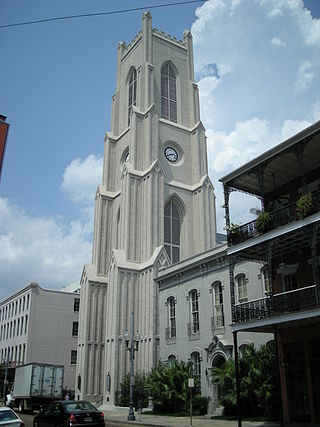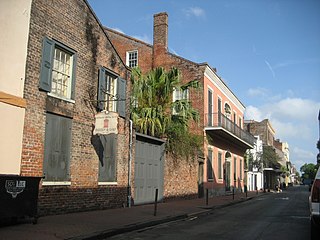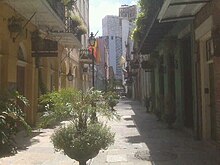
The French Quarter, also known as the Vieux Carré, is the oldest neighborhood in the city of New Orleans. After New Orleans was founded in 1718 by Jean-Baptiste Le Moyne de Bienville, the city developed around the Vieux Carré, a central square. The district is more commonly called the French Quarter today, or simply "The Quarter", related to changes in the city with American immigration after the 1803 Louisiana Purchase. Most of the extant historic buildings were constructed either in the late 18th century, during the city's period of Spanish rule, or were built during the first half of the 19th century, after U.S. purchase and statehood.

Canal Street is a major thoroughfare in the city of New Orleans. Forming the upriver boundary of the city's oldest neighborhood, the French Quarter or Vieux Carré, it served historically as the dividing line between the colonial-era (18th-century) city and the newer American Sector, today's Central Business District.

The Central Business District (CBD) is a neighborhood of the city of New Orleans, Louisiana, United States.

Rampart Street is a historic avenue located in New Orleans, Louisiana.

The culture of New Orleans is unique among, and distinct from, that of other cities in the United States, including other Southern cities. New Orleans has been called the "northernmost Caribbean city" and "perhaps the most hedonistic city in the United States". Over the years, New Orleans has had a dominant influence on American and global culture.

Chanson du Vieux Carré : Connick On Piano, Volume 3 (2007) is Harry Connick Jr.'s 3rd album from Marsalis Music. It is recorded with his big band, and features mostly instrumental tracks except for two vocal tracks by band members Leroy Jones on "Bourbon Street Parade" and Lucien Barbarin on "Lucious,".

Brennan's is a Creole restaurant in the French Quarter of New Orleans, Louisiana.

James Gallier was a prominent nineteenth-century Irish-born American architect, most famed for his buildings in New Orleans. Gallier Hall, which he designed and once served as New Orleans City Hall, is named after him.
The 1440 Canal, also formerly known as the Tidewater Building and Tidewater Place, located at 1440 Canal Street in the Medical District of the Central Business District of New Orleans, Louisiana, is officially a 24-story, 288 feet (88 m)-tall high-rise building designed by Kessels-Diboll-Kessels. The building has lesser-known 25th and 26th floors that are accessible only from the 24th floor and are much smaller in area than the other floors.

Barthélemy Lafon (1769–1820) was a notable Creole architect, engineer, city planner, and surveyor in New Orleans, Louisiana. He appears to have had a double life, as a respectable architect, engineer, and citizen; but also as a privateer, smuggler, and pirate. In later life his association with piracy, specifically with Jean Lafitte and Pierre Lafitte became public knowledge.

St. Patrick's Church is a Catholic church and parish in the Archdiocese of New Orleans, Louisiana, United States. The parish was founded in 1833, and the current structure was completed in 1840. It is the second-oldest parish in New Orleans, located upriver from the French Quarter at 724 Camp Street in what is now the Central Business District. The building, a National Historic Landmark, is one of the nation's earliest and finest examples of Gothic Revival architecture.

The buildings and architecture of New Orleans reflect its history and multicultural heritage, from Creole cottages to historic mansions on St. Charles Avenue, from the balconies of the French Quarter to an Egyptian Revival U.S. Customs building and a rare example of a Moorish revival church.
James Harrison Dakin was an American architect who designed Neo-Gothic buildings and was the architect for the Old Louisiana State Capitol, Old Bank of Louisville, and other public buildings.

Frenchmen Street is in the 7th Ward of New Orleans, Louisiana. It is best known for the three-block section in the Faubourg Marigny neighborhood which since the 1980s has developed as the center of many popular live-music venues, including Cafe Negril, Favela Chic, Vaso, Apple Barrel, Blue Nile, Snug Harbor, the Spotted Cat, and the Maison. In addition the street has numerous restaurants, bars, a premier bicycle shop, a record store, a book shop, and other local businesses.

The Hermann–Grima House is a historic house museum in the French Quarter of New Orleans, Louisiana, United States. The meticulously restored home reflects 19th century New Orleans. It is a Federal-style mansion with courtyard garden, built in 1831. It has the only extant horse stable and 1830s open-hearth kitchen in the French Quarter.

Louisiana State Bank Building is a historic commercial building at Royal and Conti Streets in the French Quarter of New Orleans, Louisiana. Built in 1820, it was the last structure designed by nationally prominent architect Benjamin Henry Latrobe, who died from yellow fever in New Orleans before its construction. It has also been known as the Manheim Galleries building, from a long-time tenant. More recently, it has housed "Latrobe's", an event venue. It was declared a National Historic Landmark in 1983.

William Woodward was a U.S. artist and educator, best known for his impressionist paintings of New Orleans and the Gulf Coast of the United States.

The cuisine of New Orleans encompasses common dishes and foods in New Orleans, Louisiana. It is perhaps the most distinctively recognized regional cuisine in the United States. Some of the dishes originated in New Orleans, while others are common and popular in the city and surrounding areas, such as the Mississippi River Delta and southern Louisiana. The cuisine of New Orleans is heavily influenced by Creole cuisine, Cajun cuisine, and soul food. Later on, due to immigration, Italian cuisine and Sicilian cuisine also has some influence on the cuisine of New Orleans. Seafood also plays a prominent part in the cuisine. Dishes invented in New Orleans include po' boy and muffuletta sandwiches, oysters Rockefeller and oysters Bienville, pompano en papillote, and bananas Foster, among others.

The St. Louis Hotel was built in 1838 at the corner of St. Louis and Chartres Street in New Orleans, Louisiana, United States. Originally it was referred to as the City Exchange Hotel. Along with the St. Charles Hotel, the St. Louis has been described as the place where the history of New Orleans happened. The St. Louis "flourished at high tide" until the American Civil War, served as the de facto Louisiana state capital during Reconstruction, and then fell into a long slow decline until it was demolished around 1914.

The New Orleans Lower Central Business District is a historic district in New Orleans, Louisiana which was listed on the National Register of Historic Places (NRHP) in 1991. It may be referred to as Lower Central Business District. Along with the NRHP-listed New Orleans Upper Central Business District to the south, across the redeveloped Poydras Street, it is included within the larger New Orleans Central Business District area. To the north, between N. Peters and N. Rampart, the district borders the historic, NRHP-listed Vieux Carre, which is a U.S. National Historic Landmark.




















